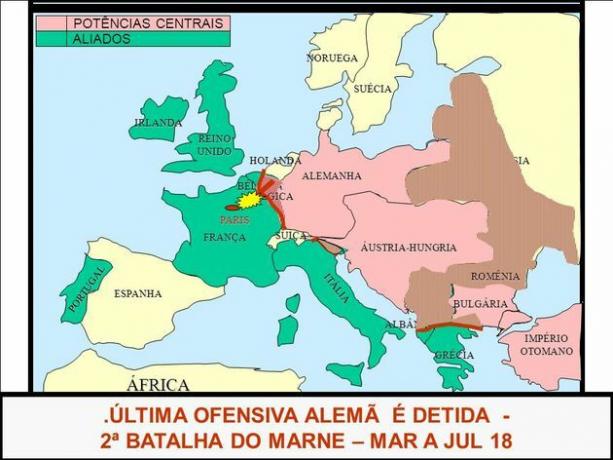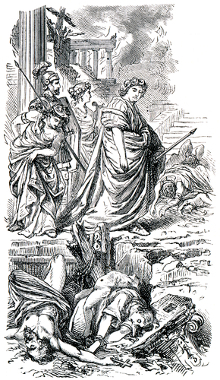For study purposes, the First World War (1914-1918) is divided into 3 phases:
- War of Movement (1914)
- War of Position or Trench (1915-1917)
- Second War of Movement/Final Phase (1918)
War of Movement (1914)
In the first months of the war, the troop movement strategy was widely used for taking positions at the front.
The Germans have moved quickly and within a few weeks are less than 50 km from Paris. For his part, the French general Joffre, manages to repel the advance in the bloody battle of the Marne, in 1914.
The war strategy followed the mold of the 19th century: an attack by cavalry charges, accompanied by infantry. However, times had changed and it was not efficient in the face of positions defended by machine guns under artillery coverage.
Gradually, the armies adopted the mechanism of dug trenches along the entire combat front.
Read more: Causes of the First World War.
War of Position or Trench (1915-1917)
The second phase of the war was marked by the trench warfare or of Position.
Unable to break through the enemy's defense lines, the belligerents want to preserve the conquered positions at any cost.
The trenches are, therefore, a defensive strategy, initially adopted by the German armies, it was also used by the Allies.
The trenches were veritable defensive complexes composed of tunnels and ditches. There, for months, thousands of soldiers fought, ate and slept, sheltered from the gunfire.
However, they were exposed to artillery projectiles, chemical weapons and air attacks, in addition to the elements and diseases caused by the unhealthy environment. Every two weeks the soldiers in the trenches were replaced by those in the rear.
Find out what were the Major Battles of World War I.

Ahead of the trenches, the ground was covered with stakes and a barbed wire guard. A few hundred meters separated the enemy lines, forming a rugged terrain between them.
In this way, many soldiers succumbed trapped in wire fences, shot by machine guns or cannon fire. The wounded could only be rescued at night, and even then it was a very dangerous operation.
It was the bloodiest period of the war, where battles lasted weeks or even months, with the loss and resumption of positions and a large casualty balance for both sides. Likewise, there was no achievement of significant positions for the belligerents.
This strategy remained effective until the use of tanks by the British in 1916, when they managed to break through the trench defenses.
1917
The year 1917 is a milestone in the war.
occurs to Russian revolution where Emperor Nicholas II and his family are imprisoned. The new government, of socialist orientation, decided to withdraw from the battlefield, signing the Treaty of Brest-Litovski with the Germans.
It is also the year that the United States enters the war on the side of the Allied Powers.
Second War of Movement/Final Phase (1918)
With the help of the United States, the Allies regain the initiative for war. Even so, armies still face very tough battles where casualties on both sides are huge.
The most famous of these is perhaps the second battle of the Marne, where the Germans were expelled from French territory.

Without gaining popular support and support from his own officers, Kaiser Wilhelm II had to accept the terms of surrender. Faced with the Spartacist revolt, which broke out in Berlin, the Kaiser resigns and retreats to Holland.
The peace was signed on November 11, 1918, ending four years of bloody conflict.
read more:
- First World War
- Brazil in World War I
- Treaty of Versailles (1919)
- Aftermath of the First World War
- Questions about the First World War
- Movies about the First World War


